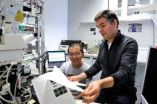(Press-News.org) Preliminary basic research and clinical findings have demonstrated that electroacupuncture therapy exhibits positive effects in ameliorating depression. However, most studies of the underlying mechanism are at the single gene level; there are few reports regarding the mechanism at the whole-genome level. Using a rat genomic gene-chip, Dr. Dongmei Duan and co-workers from General PLA Hospital in China profiled hippocampal gene expression changes in rats after electroacupuncture therapy. Electroacupuncture therapy alleviated depression-related manifestations in the model rats. Using gene-chip analysis, electroacupuncture at Baihui (DU20) and Yintang (EX-HN3) regulates the expression of 21 genes. Real-time PCR showed that the genes Vgf, Igf2, Tmp32, Loc500373, Hif1a, Folr1, Nmb, and Rtn were upregulated or downregulated in depression and that their expression tended to normalize after electroacupuncture therapy. These results, published in the Neural Regeneration Research (Vol. 9, No. 1, 2014), indicate that electroacupuncture modulates depression by regulating the expression of particular genes.
INFORMATION:
Article: " Hippocampal gene expression in a rat model of depression after electroacupuncture at the Baihui and Yintang acupoints," by Dongmei Duan1, Xiuyan Yang2, Tu Ya3, Liping Chen1 (1 Department of Traditional Chinese Medicine of South Building, Chinese PLA General Hospital, Beijing 100853, China; 2 Institute of Health Maintenance, Beijing University of Chinese Medicine, Beijing 100029, China; 3 School of Acupuncture and Moxibustion, Beijing University of Chinese Medicine, Beijing 100037, China)
Duan DM, Yang XY, Ya T, Chen LP. Hippocampal gene expression in a rat model of depression after electroacupuncture at the Baihui and Yintang acupoints. Neural Regen Res. 2014;9(1):76-83.
Contact: Meng Zhao
eic@nrren.org
86-138-049-98773
Neural Regeneration Research
http://www.nrronline.org/
Electroacupuncture effect on depression and variation of polygenes expression
2014-03-24
ELSE PRESS RELEASES FROM THIS DATE:
Tecnalia presents a smart home able to detect symptoms of neurodegenerative diseases
2014-03-24
The world population is rapidly ageing, which means the number of disabled and dependent people is increasing since these rates increase with age, particularly after the age of 80. This is the context in which the Tecnalia centre for applied research has designed a system of sensors which when fitted in a home, allows a person's habits and activities to be monitored and any changes in his/her habits and activities that could be a symptom of disorders relating to neurodegenerative diseases like Alzheimer's to be detected.
Since the symptoms of diseases like Alzheimer's ...
'MaMTH' advance: New technology sheds light on protein interactions
2014-03-24
TORONTO — Scientists have a better way to study human proteins — large molecules that are part of every cell in the body — thanks to a new technology developed by University of Toronto researchers. The technology tracks a class of proteins called membrane proteins as they interact with other proteins to either maintain health or contribute to disease.
Membrane proteins make up about one third of all proteins in the human body, and their malfunction is associated with more than 500 diseases. But they've been hard to study because understanding their role depends on observing ...
Experiment opens the door to multi-party quantum communication
2014-03-24
In the world of quantum science, Alice and Bob have been talking to one another for years. Charlie joined the conversation a few years ago, but now with spacelike separation, scientists have measured that their communication occurs faster than the speed of light.
For the first time, physicists at the Institute for Quantum Computing (IQC) at the University of Waterloo have demonstrated the distribution of three entangled photons at three different locations (Alice, Bob and Charlie) several hundreds of metres apart, proving quantum nonlocality for more than two entangled ...
Fast and reliable: New mechanism for speedy transmission in basket cells discovered
2014-03-24
This news release is available in German.
In his third major research paper since December 2013, IST Austria Professor Peter Jonas together with his collaborator, postdoc Hua Hu, identifies a new subcellular mechanism for reliable, fast transmission in the so-called basket cells of the brain. The results will be published on the website of Nature Neuroscience on March 23, 2014 (DOI 10.1038/nn.3678)
IST Austria president Thomas Henzinger expressed his delight: "This is an extraordinary streak of publications in major journals which once more emphasizes the outstanding ...
Heparin might be the key to prevent prion conversion and disease
2014-03-24
Prions are infectious agents responsible for neurodegenerative diseases such as bovine spongiform encephalitis (commonly known as "mad cow disease") and Creutzfeldt–Jakob disease in humans.
Since the discovery in the 60s that an incurable and fatal disease could be caused by an infectious agent formed by nothing but converted misfolded proteins, the mechanisms responsible for the conversion of a normal prion protein into its infectious counterpart – the scrapie prion – have been relentlessly investigated. Researchers now know that once converted into the scrapie form, ...
p53 cuts off invading cancer cells
2014-03-24
VIDEO:
In the absence of Omi, Ras-transformed tumor cells form invasive lamellipodial protrusions.
Click here for more information.
The tumor suppressor p53 does all it can to prevent oncogenes from transforming normal cells into tumor cells by killing defective cells or causing them to become inactive. Sometimes oncogenes manage to initiate tumor development in the presence of p53, but, even then, the tumor suppressor doesn't give up and focuses its efforts instead on limiting ...
How developing sperm stick to the right path
2014-03-24
The process of producing high-quality, fertile sperm requires many steps. A study in The Journal of Cell Biology shows how the transcription factor p73 promotes this process by regulating the adhesions between developing sperm and their support cells.
The p53 family of transcription factors has an ancient and well-conserved function in protecting reproductive cells. In mammals, for example, p63 promotes the death of eggs and sperm that have sustained DNA damage, and female mice lacking p73 are infertile due to defects in egg development. Male mice lacking p73 are also ...
Radiation therapy and cancer vaccines: Timing is everything
2014-03-24
(PHILADELPHIA) – Radiation therapy fights cancer in more ways than one. Not only does it force cancer cells to self-destruct, but several studies demonstrate that it also activates the immune system to attack tumor cells. This activation can be used to boost current immunotherapies, such as anti-tumor vaccines, to produce better clinical results. What's less clear, however, is exactly how to combine the two therapies to get the best bang for the therapeutic buck.
To address this question, researchers at Thomas Jefferson University tested an experimental cancer vaccine ...
Unfolded proteins collapse when exposed to heat and crowded environments
2014-03-24
Proteins are important molecules in our body and they fulfil a broad range of functions. For instance as enzymes they help to release energy from food and as muscle proteins they assist with motion. As antibodies they are involved in immune defence and as hormone receptors in signal transduction in cells. Until only recently it was assumed that all proteins take on a clearly defined three-dimensional structure – i.e. they fold in order to be able to assume these functions. Surprisingly, it has been shown that many important proteins occur as unfolded coils. Researchers ...
Diabetes drug shows promise in reducing Alzheimer's disease in an experimental model
2014-03-24
(Boston) Researchers from Boston University School of Medicine (BUSM) have found that the diabetic drug, pramlintide, reduces amyloid-beta peptides, a major component of Alzheimer's disease (AD) in the brain and improves learning and memory in two experimental AD models. These findings, which appear online in Molecular Psychiatry, also found AD patients have a lower level of amylin in blood compared to those without this disease. These results may provide a new avenue for both treatment and diagnosis of AD.
AD is a degenerative brain disease associated with severe functional ...



